 |
Recycling of oceanic crust from a stagnant slab in the mantle transition zone:
Evidence from Cenozoic continental basalts in Zhejiang Province, SE China |
Yan-Qing Li1, Chang-Qian Ma1, Paul T. Robinson1, Qin Zhou1, Ming-Liang Liu1,2
1State Key Laboratory of Geological Process and Mineral Resources, Faculty of Earth Sciences, China University of Geosciences, Wuhan 430074, China; yqlicug@sina.cn; cqma@cug.edu.cn; paulrobinson94@hotmail.com; 380500200@qq.com
2Faculty of Earth Resources, China University of Geosciences, Wuhan 430074, China; 598768836@qq.com
This webpage is a summary of: Li, Yan-Qing, Chang-Qian Ma, Paul T. Robinson, Qin Zhou, Ming-Liang Liu, Recycling of oceanic crust from a stagnant slab in the mantle transition zone: Evidence from Cenozoic continental basalts in Zhejiang Province, SE China, Lithos, 230, 146-165, 2015.
Introduction
Cenozoic intra-plate basalts of eastern China display many features typical of ‘OIB–type’ lavas. However, their Sr-Nd isotope signatures are significantly more depleted than those of OIBs. On the basis of recent seismic tomography images for eastern China from 25° to 41°N, a high-velocity slab has been identified in the mantle transition zone at depths of 410-660 km. It is thought to be a fragment of the subducted Pacific plate (Huang & Zhao, 2006). This feature extends from the coast to 118°E. In addition, a low-velocity zone has been identified at shallow depths in the upper mantle above the slab, interpreted as an ‘upper-mantle’ plume upwelling from the mantle transition zone (Kuritani et al., 2011; Li et al., 2013). Late Cenozoic basaltic volcanoes above the stagnant slab are distributed throughout eastern China. A correlation between the distribution of such volcanoes and the extent of the subducted slab has led some researchers to suggest a genetic relationship between the two (Kuritani et al., 2013). In this paper we provide detailed mineralogical, geochemical and whole-rock Sr-Nd-Pb-Os isotopic data for the Cenozoic basalts in Zhejiang Province (SE China) (Figure 1a, b, c).

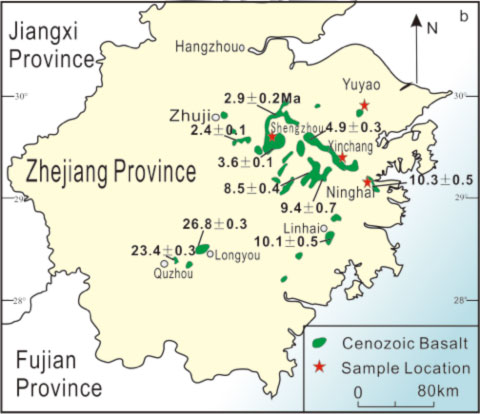
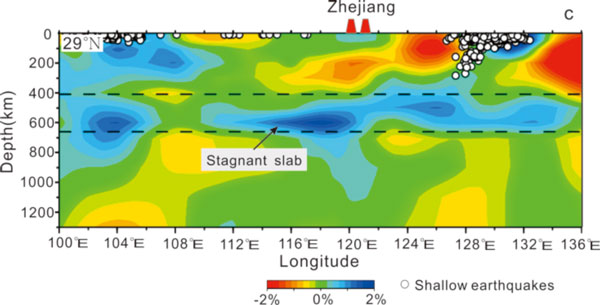
Figure 1: (a) Distribution of Cenozoic basalts in East China; (b) Cenozoic basalts and sample locations in Zhejiang Province; (c) East-west vertical cross section of P-wave velocity tomography along 29°N, indicating high and low-velocity zones beneath Zhejiang Province. The figure is slightly modified from Huang & Zhao (2006).
Parental magma(s) of the Zhejiang basalts
The Zhejiang basalts are characterized by high Fe/Mn (73±5), La/Yb (19±6) and Nb/Ta (18.8±0.4) ratios, which can be attributed to residual clinopyroxene, garnet and rutile in the mantle source. A CS-MS-A projection (Herzberg, 2011) shows that most Zhejiang basalts appear to have formed between the L+Gt+Cpx and L+Ol+Cpx+Gt cotectic at pressure ~3 GPa, and that they melted along the cotectic on the left side of the ‘thermal divide’ representing the silica-poor side. Thus we can confirm the type of source pyroxenite as low-SiO2 which could be mixed freely with partial melts of peridotites. Based on these minerals, the following hybrid source rocks are hypothesized: garnet pyroxenite/eclogite and peridotite.
The Re-Os isotopic similarity of the Zhejiang basalts to those of the Emeishan LIP implies a similar source. The most likely explanation for the extremely high Re/Os and 187Os/188Os ratios of the basalts is derivation from ancient, recycled oceanic crust to which sea water has been added. The mafic component (pyroxenite/eclogite) in the source region may reflect such recycled oceanic crust that has interacted with mantle peridotite.
Subducted oceanic crust in the source of Zhejiang basalts
Zhejiang alkali basalts have many chemical and isotopic features similar to EM1-type basalts including positive Ba, Nb, Ta anomalies and negative Pb anomalies (Figure 2). The EM1-like geochemical features of the Zhejiang basalts can be easily explained by the presence of the stagnant slab in the transition zone. In plots of 143Nd/144Nd vs. 87Sr/86Sr, 143Nd/144Nd vs. 206Pb/204Pb and 87Sr/86Sr vs. 206Pb/204Pb (Figure 3 a, b, c), all the features imply three-component mixing of DMM, EM1 and EM2. Different lithologies in the ancient (>1 Gyr) subducted oceanic slab such as oceanic crust, including pelagic sediments, cumulated mafic rocks and modified lithospheric mantle, could provide both EM1-like and EM2-like signatures in the source material of the Zhejiang basalts. Depleted continental asthenospheric mantle with depleted isotopic signatures could comprise a DMM end-member.
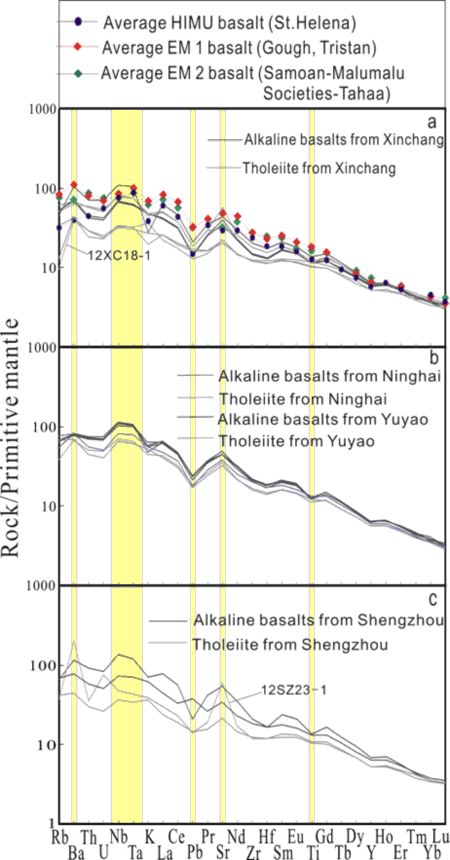
Figure 2: Trace element (a-c) abundances in whole rocks for the Zhejiang basalts. Trace element spider diagrams are normalized by primitive mantle values (McDonough & Sun 1995). Also shown for comparison are St. Helena HIMU basalts, EM1 basalts and EM2 basalts.
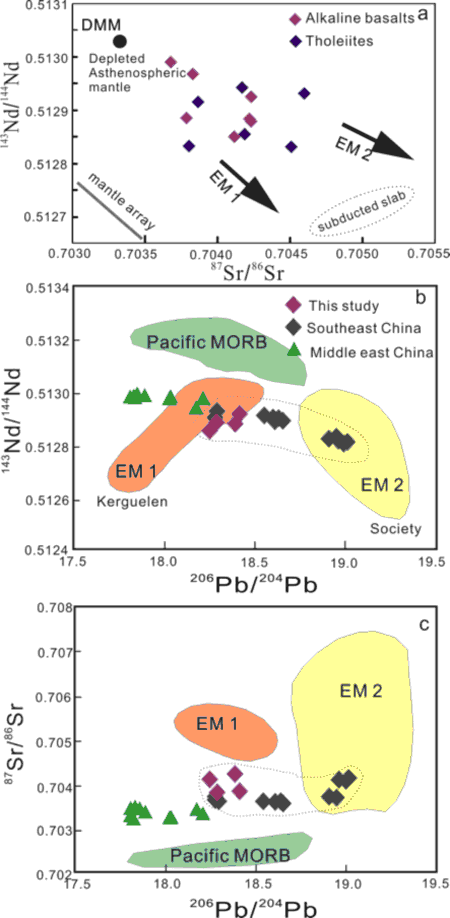
Figure 3: (a) Variations of 143Nd/144Nd vs. 87Sr/86Sr for the Zhejiang basalts. DMM component is from depleted mantle and EM-like components are from subducted oceanic slab. (b) and (c) Variations of 143Nd/144Nd, and 87Sr/86Sr vs. 206Pb/204Pb for the Zhejiang basalts.
Origin of the mixed sources of Zhejiang basalts
Subduction of the relatively young and hydrous Pacific slab into the mantle transition zone would potentially cause partial melting of the oceanic slab materials with low melting points (eclogite/pyroxenite + sediments) (Xu et al., 2012). These melts would migrate upward due to their buoyancy difference and through the weakened asthenospheric mantle, thereby obtaining their DMM component. The overlying continental lithosphere may have served as a mechanical barrier to continuous upwelling of the magmas. East China was in an extensional tectonic state during the Cenozoic, and rifting of the continental crust would have allowed further ascent of the magmas and eruption at the surface (Figure 4a, b, c).
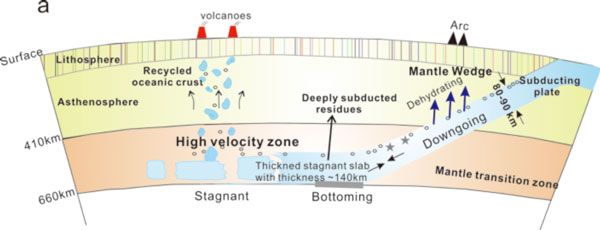
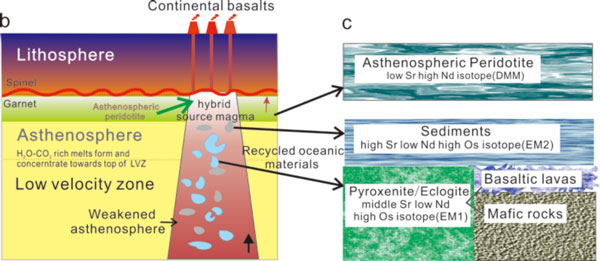
Figure 4: (a) Schematic illustration of the subducted plate underneath the Asian continent stagnating in the mantle transition zone, which supplied the enriched components in the asthenospheric peridotite matrix. This figure is modified from Li et al. (2013) and Xu et al. (2012). (b) Formation of hybrid source magma. The addition of recycled oceanic materials to the asthenosphere is shown. (c) The recognized three end members in the hybrid source magma of the Zhejiang Cenozoic basalts.
References
-
Herzberg C., 2011. Identification of Source Lithology in the Hawaiian and Canary Islands: Implications for Origins. Journal of Petrology 1, 113-146.
-
Huang J.L., Zhao D.P., 2006. High-resolution mantle tomography of China and surrounding regions. Journal of Geophysical Research 111, B09305.
-
Kuritani T., Ohtani E., Kimura J.I., 2011. Intensive hydration of the mantle transition zone beneath China caused by ancient slab stagnation. Nature Geoscience doi:10.1038/NGEO1250.
-
Kuritani T., Kimura J.I., Ohtani E., Miyamoto H., Furuyama K., 2013. Transition zone origin of potassic basalts from Wudalianchi volcano, northeast China. Lithos 156-159, 1-12.
-
Li J., Wang X., Wang X.J., Yuen D.A., 2013. P and SH velocity structure in the upper mantle beneath Northeast China: Evidence for a stagnant slab in hydrous mantle transition zone. Earth and Planetary Science Letters 367, 71-81.
-
McDonough, W.F., Sun, S.S., 1995. The composition of the Earth. Chemical Geology 120, 223–253.
-
Xu Y.G., Zhang H.H., Qiu H.N., Ge W.C., Wu F.Y., 2012. Oceanic crust components in continental basalts from Shuangliao, Northeast China: Derived from the mantle transition zone? Chemical Geology 328, 168-184.
last updated 2nd August, 2015 |
